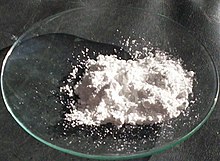Titanium compounds

The +4
Oxides, sulfides, and alkoxides

The most important oxide is TiO2, which exists in three important
The term
A variety of reduced oxides (
The
Titanium forms a variety of sulfides, but only
Nitrides and carbides
Halides
Titanium(III) and titanium(II) also form stable chlorides. A notable example is
Organometallic complexes
Owing to the important role of titanium compounds as polymerization catalyst, compounds with Ti-C bonds have been intensively studied. The most common organotitanium complex is titanocene dichloride ((C5H5)2TiCl2). Related compounds include Tebbe's reagent and Petasis reagent. Titanium forms carbonyl complexes, e.g. (C5H5)2Ti(CO)2.[23]
Anticancer therapy studies
Following the success of platinum-based chemotherapy, titanium(IV) complexes were among the first non-platinum compounds to be tested for cancer treatment. The advantage of titanium compounds lies in their high efficacy and low toxicity in vivo.[24] In biological environments, hydrolysis leads to the safe and inert titanium dioxide. Despite these advantages the first candidate compounds failed clinical trials due to insufficient efficacy to toxicity ratios and formulation complications.[24] Further development resulted in the creation of potentially effective, selective, and stable titanium-based drugs.[24]
See also
- Chromium compounds
- Titanium alloy
- Group 4 element
References
- ^ a b Greenwood & Earnshaw 1997, p. 958
- ^ Greenwood & Earnshaw 1997, p. 970
- ^ Greenwood & Earnshaw 1997, p. 960
- ^ Greenwood & Earnshaw 1997, p. 967
- ^ Greenwood & Earnshaw 1997, p. 961
- ISBN 978-0-7876-5015-5.
- ISBN 978-0-19-850340-8.
- .
- S2CID 119213226.
- ^ Greenwood & Earnshaw 1997, p. 962.
- PMID 16771446.
- ISBN 9780470132616.
- doi:10.1063/1.351465.
- ^ Schubert, E.F. "The hardness scale introduced by Friederich Mohs" (PDF). Educational resources. Troy, NY: Rensselaer Polytechnic Institute. Archived (PDF) from the original on 3 June 2010.
- ISSN 0032-4558.
- ISBN 978-981-256-605-8.
- ^ "Titanium carbide product information". H.C. Starck. Archived from the original on 22 September 2017. Retrieved 16 November 2015.
- ISBN 978-0-8330-4575-1.
- ISBN 978-3-540-64612-9.
- ISBN 978-0-470-85625-3.
- ^ Greenwood & Earnshaw 1997, p. 965
- ISBN 978-0471936237.
- ISBN 978-1891389535.
- ^ )
Works cited
- ISBN 978-0-08-037941-8.
